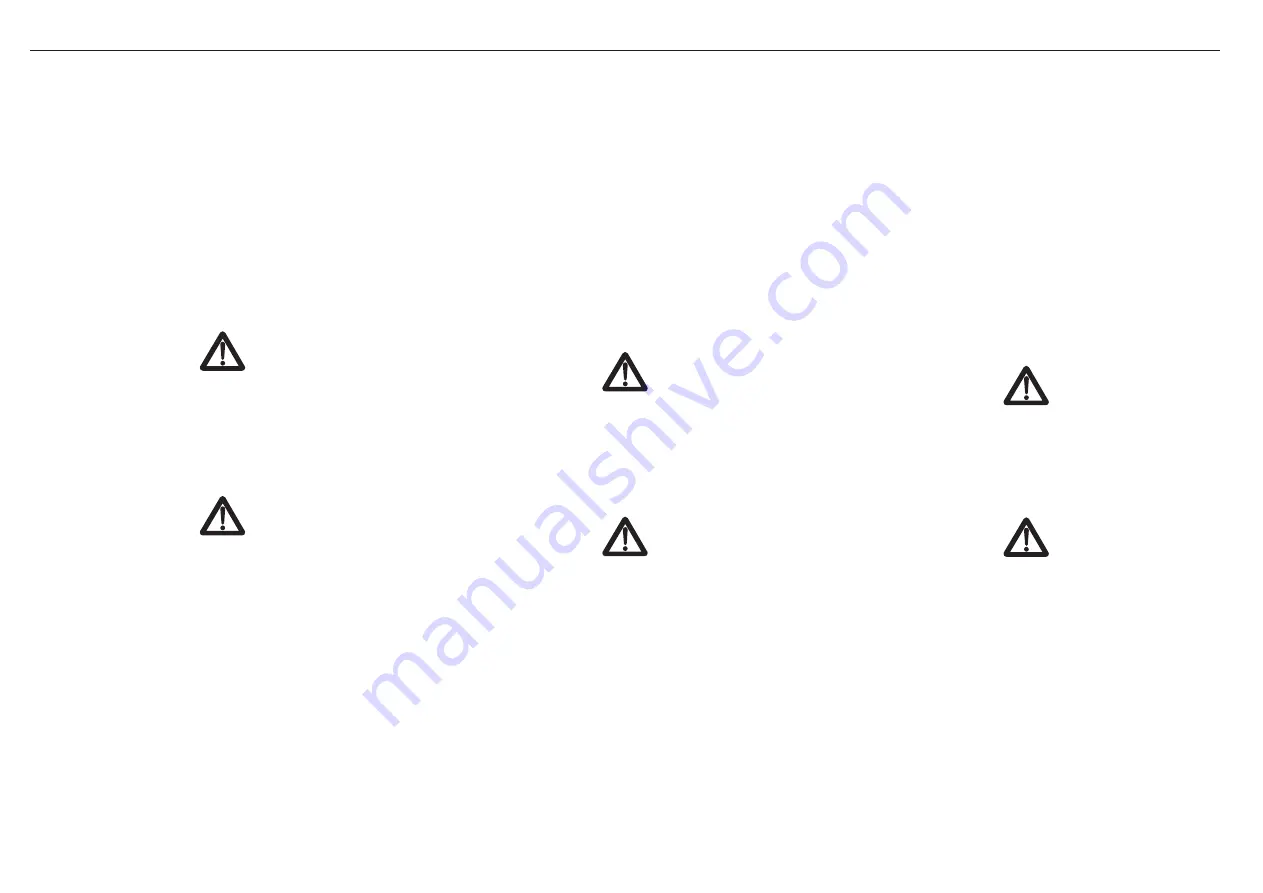
ITALIANO
ENGLISH
SUOMI
16
3.0 NORME D’USO
3.1 TRASPORTO
Se si rendesse necessario trasportare la macchina su di un lungo
percorso, questa può essere caricata sia su vagoni ferroviari che su
autocarri.
A tale scopo consultare «Dati tecnici», per il peso e le dimensioni
speci
fi
che. Queste ultime sono molto utili per controllare la possibilità
di passaggio in zone anguste.
Consigli per il carico e scarico della macchina
Per il sollevamento è necessario quindi servirsi di gru e/o carro ponte
aventi la capacità minima di 1500 Kg, e di funi, catene e ganci in ottimo
stato adatti a sostenere in totale sicurezza il peso della macchina.
Agganciare quest’ultima ai punti di sollevamento predisposti e segnati
con il simbolo gancio (21 Fig. 3).
CAUTELA
Prima di procedere alle operazioni di sollevamento, assicurarsi
che eventuali elementi mobili della macchina (ruote,castello...)
siano ben bloccati.
Assicurarsi di avere una gru di portata adeguata al sollevamento
della macchina.
Sollevare la macchina con estrema cautela e trasferirlo lentamen-
te, senza scosse o movimenti bruschi.
PERICOLO
Le operazioni di sollevamento e trasporto possono essere molto
pericolose se non effettuate con la massima cautela: allontanare
perciò i non addetti; pulire, sgomberare e delimitare la zona di
trasferimento; veri
fi
care l’integrità e l’idoneità dei mezzi a dispo-
sizione; non toccare i carichi sospesi e rimanervi a distanza di
sicurezza; durante il trasporto, i carichi non dovranno essere
sollevati più di 20 centimetri dal suolo.
Ci si deve accertare inoltre che la zona in cui si opera, sia sgombra
da ostacoli e che vi sia un suf
fi
ciente «spazio di fuga», intenden-
do con questo termine, una zona libera e sicura, in cui potersi
spostare rapidamente qualora il carico cadesse.
Il piano su cui si intende caricare la macchina, deve essere orizzon-
tale per evitare possibili spostamenti del carico.
Una volta posta la macchina sull’eventuale mezzo di trasporto, assi-
curarsi che rimanga bloccata nella sua posizione.
Fissare la macchina al piano su cui è appoggiato mediante l’ausilio di
funi adatte alla massa di cui si intende bloccare il movimento (vedere
«Dati tecnici» per il peso).
Dette funi devono essere
fi
ssate saldamente alla macchina e ben tese
3.0 USE INSTRUCTIONS
3.1 TRANSPORT
If it becomes necessary to transport the machine for a long distance,
it can be loaded onto a railway wagon or a truck.
For this purpose, consult «Technical features» for weight and speci
fi
c
dimensions. The latter are very useful to check the possibility of driving
along all types of roads.
Recommendations for loading and unloading the ma-
chine
.
For lifting purposes, use a crane and/or bridge-crane with a lifting
capacity of at least 1500 kg, plus ropes, chains and hooks in a perfect
condition and able to bear the weight of the machine in total safety.
Couple this latter to the pre-engineered lifting points marked by the
hook symbol (21 Fig. 3).
CAUTION
Before proceeding to the hoisting operations, make sure that any
any mobile elements of the machine (wheels, 3rd point hitch...)
are blocked.
Make sure to use a crane with an adequate hoisting capacity to
lift the machine.
Hoist the machine with extreme caution and transfer it slowly,
without jerks or abrupt movements.
DANGER
The operations of hoisting and transport can be very dangerous
if not carried out with the maximum caution; persons not directly
involved should be moved away. Clean, evacuate the area and
delimit the transfer zone.
Check the state, condition and suitability of the means at dis-
position.
Do not touch suspended loads, keeping them at a safe distance
During transport, the loads should not be raised more than 20
cm. from the ground.
It most be further ascertained that the operational area is free of
obstacles and that there is suf
fi
cient «escape space», meaning an
area which is free and secure into which one could move rapidly
in case a load should fall.
The surface on which the machine is to be loaded must be hori-
zontal in order to prevent possible shifting.
Once the machine is positioned on the vehicle, make sure that it re-
mains
blocked in its position.
Fasten the machine on the platform of the vehicle by means of cables
3.0 KÄYTTÖOHJEET
3.1 KULJETUS
Jos konetta on kuljetettava pitkiä matkoja, voidaan se tehdä rautateitse
tai kuorma-autolla.
Tarkista koneen paino ja muut mitat ennen kuormausta. Tiedot on hyvä
tarkistaa ennen ajamista esim. kapeilla teillä.
Koneen kuormaus- ja nostosuosituksia
.
Koneen nostamiseksi käytetään nosturia, jonka nostoteho on väh.
1 500 kg. Nostoon käytetään hyvässä kunnossa olevia nostoköysiä,
-ketjuja tai -vaijereita joiden avulla nosto voidaan tehdä turvallisesti.
Nostoketjut tms. kytketään olemassa oleviin, tarralla merkittyihin nos-
tosilmukoihin (21 kuva 3).
VAROITUS
Ennen koneen nostamista on varmistettava, ettei koneessa ole
irrallisia osia.
Varmista, että käytössä oleva nosturi on riittävän tehokas nos-
totoimenpiteeseen.
Ole varovainen konetta nostettaessa ja tee siirrot hitaasti ilman
nopeita liikkeitä.
VAARA
Nosto- ja kuljetustoimenpiteet voivat olla hyvin vaarallisia, ellei
niitä tehdä erityistä varovaisuutta noudattaen; kukaan ulkopuo-
linen ei saa oleskella vaara-alueella. Valvo, ettei kukaan turhaan
oleskele vaara-alueella.
Tarkista käytössä olevien laitteiden sopivuus ja kunto.
Älä koske riippuvaan taakkaan ja pidä siihen riittävä etäisyys.
Siirron aikana konetta nostetaan enintään 20 cm maasta.
Lisäksi on varmistettava, ettei nostoalueella ole kiinteitä esineitä,
jotka estävät siirtymisen pois alta jos kone putoaa.
Kuormauskohdan tulee olla tasainen niin, että kaatuminen voi-
daan estää.
Kun kone on asetettu kuormalavan päälle, on varmistettava sen pai-
kallaan pysyminen.
Kiinnitä kone kuljetusalustaan lukitusketjuilla, joiden vetolujuus vastaa
koneen painoa (katso Tekniset tiedot).
Ketjut on kiinnitettävä tukevasti koneen ja kuljetusalustan kiinnikkeiden
Summary of Contents for GIRAFFA 160
Page 43: ...43 ITALIANO ENGLISH SUOMI...
















































